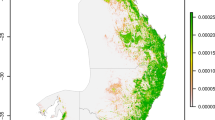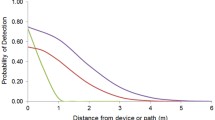Abstract
Effective surveillance is critical to managing biological invasions via early detection and eradication. The efficiency of surveillance systems may be affected by the spatial arrangement of sample locations. We investigate how the spatial arrangement of sample points, ranging from random to fixed grid arrangements, affects the probability of detecting a target population (survey sensitivity) and the overall cost of detecting and eradicating populations invading over time. For single period surveys, regular sampling patterns outperform the equivalent number of random samples at intermediate sample densities, but only when sample sensitivity is high. Otherwise, sample point arrangement has little effect on survey sensitivity, which can be modelled reasonably accurately using a Poisson approximation. For multiple period surveys, we find little difference in the costs of sample point arrangements for most combinations of parameters tested. However, the costs of different arrangements vary when sampling methods have higher sensitivity and trap densities are low, a situation representative of many real surveillance programs. In particular, our results suggest that dynamic trapping arrangements increase the efficiency of detection when traps are sparse relative to the size of target populations. Also, for the scenarios we considered managers may exercise some freedom in allocating sample point locations. Placing individual traps or samples in perceived higher probability sites at the local scale is unlikely to diminish the probability of detection at the broader scale.




Similar content being viewed by others
References
Albert CH, Yoccoz NG, Edwards TC Jr, Graham CH, Zimmermann NE, Thuiller W (2010) Sampling in ecology and evolution—bridging the gap between theory and practice. Ecography 33:1028–1037
Andrew NL, Mapstone BD (1987) Sampling and the description of spatial pattern in marine ecology. Oceanogr Mar Biol Annu Rev 25:39–90
Barry J, Nicholson M (1993) Measuring the probability of patch detection for four spatial sampling designs. J Appl Stat 20:353–362
Bogich TL, Liebhold AM, Shea K (2008) To sample or eradicate? A cost minimization model for monitoring and managing an invasive species. J Appl Ecol 45:1134–1142
Cacho OJ, Hester SM (2011) Deriving efficient frontiers for effort allocation in the management of invasive species. Aust J Agric Resour Econ 55:72–89
Cacho JO, Spring D, Pheloung P, Hester S (2006) Evaluating the feasibility of eradicating an invasion. Biol Invasions 8:903–917
Cacho OJ, Spring D, Hester S, Mac Nally R (2010) Allocating surveillance effort in the management of invasive species: a spatially-explicit model. Environ Model Softw 25:444–454
Carpenter PJ, Ding A, Cheng L (2012) Identifying groundwater contamination using resistivity surveys at a landfill near Maoming, China. Nat Educ Knowl 3(7):20
Chadès I, McDonald-Madden E, McCarthy MA, Wintle B, Linkie M, Possingham HP (2008) When to stop managing or surveying cryptic threatened species. Proc Natl Acad Sci 105:13936–13940
Epanchin-Niell RS, Haight RG, Berec L, Kean JM, Liebhold AM (2012) Optimal surveillance and eradication of invasive species in heterogeneous landscapes. Ecol Lett 15:803–812
Epanchin-Niell R, Brockerhoff E, Kean J, Turner J (2014) Designing cost-efficient surveillance for early-detection and control of multiple invading species. Ecol Appl. doi:10.1890/13-1331.1
Hauser CE, McCarthy MA (2009) Streamlining ‘search and destroy’: cost-effective surveillance for invasive species management. Ecol Lett 12:683–692
Hester S, Cacho O (2012) Optimization of search strategies in managing biological invasions: a simulation approach. Hum Ecol Risk Assess: Int J 18:181–199
Hoye BJ, Munster VJ, Nishiura H, Klaassen M, Fouchier RAM (2010) Surveillance of wild birds for avian influenza virus. Emerg Infect Dis 16(12)
Jarrad FC, Barrett S, Murray J, Stoklosa R, Whittle P, Mengersen K (2011) Ecological aspects of biosecurity surveillance design for the detection of multiple invasive animal species. Biol Invasions 13:803–818
Liebhold AM, Tobin PC (2006) Growth of newly established alien populations: comparison of North American gypsy moth colonies with invasion theory. Popul Ecol 48:253–262
Liebhold AM, Tobin PC (2008) Population ecology of insect invasions and their management. Annu Rev Entomol 53:387–408
Marsh DM, Trenham PC (2008) Current trends in plant and animal population monitoring. Conserv Biol 22:647–655
Martin PAJ, Cameron AR, Greiner M (2007) Demonstrating freedom from disease using multiple complex data sources 1: a new methodology based on scenario trees. Prev Vet Med 79:71–97
Mehta SV, Haight RG, Homans FR, Polasky S, Venette RC (2007) Optimal detection and control strategies for invasive species management. Ecol Econ 61:237–245
Monke J (2004). Funding plant and animal health emergencies: transfers from the Commodity Credit Corporation. US Congressional Information Service, Library of Congress. CRS Report RL32504. 13 pp. (available at http://research.policyarchive.org/2146.pdf)
Myers JH, Savoie A, Van Randen E (1998) Eradication and pest management. Annu Rev Entomol 43:471–491
Nicholson M, Barry J (1996) Survey design for detecting patches. J Appl Stat 23:361–368
Nicholson M, Barry J (2005) Target detection from a classical and a Bayesian viewpoint. J Appl Stat 32:475–482
Perry JN, Liebhold AM, Rosenberg MS, Dungan J, Miriti M, Jakomulska A, Citron-Pousty S (2002) Illustrations and guidelines for selecting statistical methods for quantifying spatial pattern in ecological data. Ecography 25:578–600
Quilici S, Donner P (2012) Analysis of exotic fruit fly trapping networks. EPPO Bull 42:102–108
Regan TJ, Chadès I, Possingham HP (2011) Optimally managing under imperfect detection: a method for plant invasions. J Appl Ecol 48:76–85
Roberts EA, Ziegler A (2007) Gypsy moth population monitoring and data collection. In: Tobin PC, Blackburn LM (eds) Slow the spread: a national program to manage the gypsy moth. General Technical Report NRS-6, US Department of Agriculture, Forest Service, Northern Research Station, Newtown Square, PA, pp 33–46
Schwalbe CP (1981) Disparlure-baited traps for survey and detection. In: Doane CC, McManus ML (eds) The gypsy moth: research toward integrated pest management. USDA Technical Bulletin 1584, pp 542–548
Stevens DL Jr, Olsen AR (2004) Spatially balanced sampling of natural resources. J Am Stat Assoc 99:262–278
Tobin PC, Robinet C, Johnson DM, Whitmire SL, Bjørnstad ON, Liebhold AM (2009) The role of Allee effects in gypsy moth, Lymantria dispar (L.), invasions. Popul Ecol 51:373–384
Tobin PC, Kean JM, Suckling DM, McCullough DG, Herms DA, Stringer LD (2014) Determinants of successful arthropod eradication programs. Biol Invasions 16:401–414
Veit RR, Lewis MA (1996) Dispersal, population growth, and the Allee effect: dynamics of the house finch invasion of eastern North America. Am Nat 148:255–274
Venette RC, Moon RD, Hutchison WD (2002) Strategies and statistics of sampling for rare individuals. Annu Rev Entomol 47:143–174
Acknowledgments
We would like to thank J. Blackwood, A. Hastings, D. Herms, D. McCullough, M. Suckling, P. Tobin and T. Yamanaka for helpful discussions. This work is the product of a National Center for Ecological Analysis and Synthesis (NCEAS) Working Group supported by the U.S. Forest Service Southern Threat Assessment Center and NCEAS, which is funded by the National Science Foundation (Grant DEB-0553768), the University of California–Santa Barbara, and the State of California. LB and JMK are grateful for institutional support RVO:60077344 and New Zealand’s Better Border Biosecurity program (www.b3nz.org), respectively. RGH and AML acknowledge the support of the U.S. Forest Service Northern Research Station.
Author information
Authors and Affiliations
Corresponding author
Electronic supplementary material
Below is the link to the electronic supplementary material.
Rights and permissions
About this article
Cite this article
Berec, L., Kean, J.M., Epanchin-Niell, R. et al. Designing efficient surveys: spatial arrangement of sample points for detection of invasive species. Biol Invasions 17, 445–459 (2015). https://doi.org/10.1007/s10530-014-0742-x
Received:
Accepted:
Published:
Issue Date:
DOI: https://doi.org/10.1007/s10530-014-0742-x




